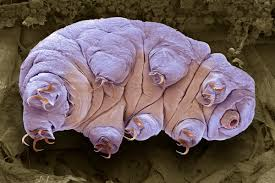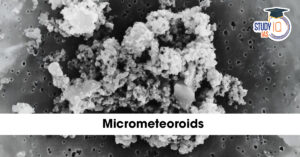Table of Contents
About Tardigrades
- They are also known as water bears or moss piglets.
- They are microscopic, water-dwelling animals belonging to the phylum Tardigrada.
- Physical Characteristics:
- Body Structure: They have a segmented body with four pairs of stubby legs, each ending in claws or disks that help them grip surfaces.
- Cuticle: Covered by a tough, flexible cuticle that allows them to withstand various environmental stresses.

- Habitat:
- Mosses and Lichens: Commonly inhabit these plants, where they absorb moisture.
- Soil: Live in the upper layers of soil and leaf litter.
- Aquatic Environments: Found in freshwater, marine environments, and even extreme habitats like hot springs and deep-sea sediments.
- Ability to survive extreme conditions:
- Desiccation: They can survive complete dehydration by entering a cryptobiotic state, effectively suspending their metabolism.
- Extreme Temperatures: Can endure temperatures from just above absolute zero (-273°C) to over 150°C.
- Radiation: Capable of withstanding high levels of ionising radiation.
- High Pressure: Survive pressures greater than those found in the deepest ocean trenches.
- Vacuum of Space: Tardigrades have been shown to survive exposure to the vacuum and radiation of outer space.
- Tardigrades reproduce both sexually and asexually.
- Tardigrades play an important role in ecosystems by contributing to nutrient cycling and serving as bioindicators of environmental health due to their sensitivity to changes in habitat conditions.
How Tardigrades Resist High Radiation
- DNA Repair Protein (TRID1): This protein is essential for repairing double-strand breaks in DNA caused by radiation exposure. Its activity allows tardigrades to recover from genetic damage effectively.
- Gene Activation for Mitochondrial Proteins: Upon exposure to radiation, a specific gene is activated that produces two proteins necessary for mitochondrial synthesis. These proteins also play a role in repairing DNA, providing an additional layer of protection against radiation-induced damage.
- Antioxidant Pigments (Betalains): Tardigrades produce betalains, antioxidant pigments that help neutralise harmful reactive chemicals generated by radiation within their cells.


 National Maritime Heritage Complex (NMHC...
National Maritime Heritage Complex (NMHC...
 Reforming Fertiliser Subsidy in India: N...
Reforming Fertiliser Subsidy in India: N...
 Micrometeoroids: Tiny Space Particles, M...
Micrometeoroids: Tiny Space Particles, M...

























